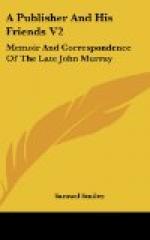Yours, etc.,
BYRON.
Mr. Murray was of course very much concerned at this decision, and remonstrated. Three days later Lord Byron revoked his determination. To Mr. Murray he wrote (May 1, 1814):
“If your present note is serious, and it really would be inconvenient, there is an end of the matter; tear my draft, and go on as usual: in that case, we will recur to our former basis.”
Before the end of the month Lord Byron began the composition of his next poem, “Lara,” usually considered a continuation of “The Corsair.” It was published conjointly with Mr. Rogers’s “Jacqueline.” “Rogers and I,” said Lord Byron to Moore, “have almost coalesced into a joint invasion of the public. Whether it will take place or not, I do not yet know, and I am afraid ‘Jacqueline’ (which is very beautiful) will be in bad company. But in this case, the lady will not be the sufferer.”
The two poems were published anonymously in the following August (1814): Murray allowed 500 guineas for the copyright of each.
CHAPTER X
MR. MURRAY’S REMOVAL TO 50, ALBEMARLE STREET
We must now revert to the beginning of 1812, at which time Mr. William Miller, who commenced business in Bond Street in 1791, and had in 1804 removed to 50, Albemarle Street, desired to retire from “the Trade.” He communicated his resolve to Mr. Murray, who had some time held the intention of moving westward from Fleet Street, and had been on the point of settling in Pall Mall. Murray at once entered into an arrangement with Miller, and in a letter to Mr. Constable of Edinburgh he observed:
John Murray to Mr. A. Constable.
May 1, 1812.
“You will probably have heard that Miller is about to retire, and that I have ventured to undertake to succeed him. I had for some time determined upon moving, and I did not very long hesitate about accepting his offer. I am to take no part of his stock but such as I may deem expedient, and for it and the rest I shall have very long credit. How far it may answer, I know not; but if I can judge of my own views, I think it may prove an advantageous opening. Miller’s retirement is very extraordinary, for no one in the trade will believe that he has made a fortune; but from what he has laid open to me, it is clear that he has succeeded. In this arrangement, I propose of course to dispose of my present house, and my medical works, with other parts of my business. I have two offers for it, waiting my decision as to terms.... I am to enter at Miller’s on September 29th next.” [Footnote: The Fleet Street business was eventually purchased by Thomas and George Underwood. It appears from the “Memoirs of Adam Black” that Black was for a short time a partner with the Underwoods. Adam Black quitted the business in 1813. Upon the failure of the Underwoods in 1831, Mr. Samuel Highley, son of Mr. Murray’s former partner, took possession, and the name of Highley again appeared over the door.]




